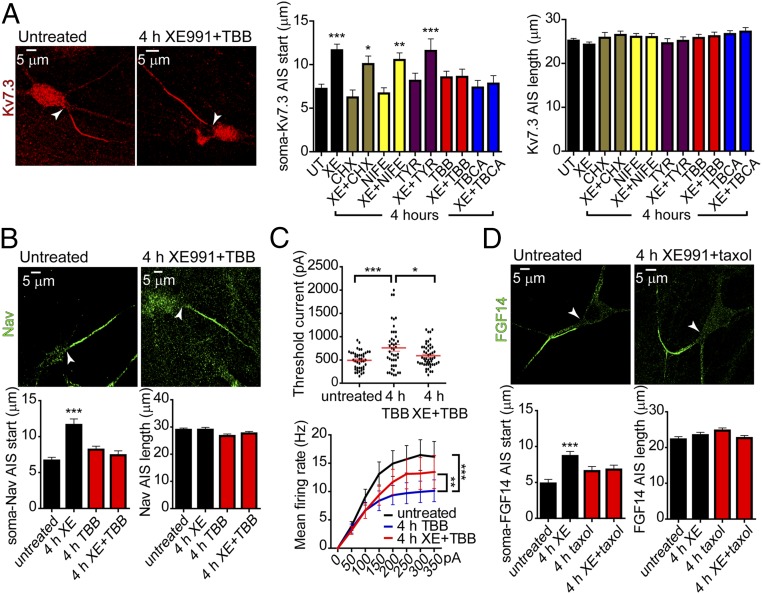Fig. 7.
Inhibition of CK2 prevents the adaptive changes in intrinsic excitability and in the distal shift of Kv7.3 and Nav channels along the AIS of cultured hippocampal neurons. (A, Left) Kv7.3 immunostaining of an untreated neuron and a neuron chronically exposed to 10 µM XE991 together with 10 µM TBB (a CK2 inhibitor) for 4 h. (Center) Several blockers were added together with XE991 (XE) for 4 h; 30 µM cycloheximide (CHX, a protein synthesis inhibitor), 1 µM nifedipine (NIFE, an l-type calcium channel blocker), and 10 µM tyrphostin 25 (TYR, a tyrosine kinase inhibitor) did not affect the distal shift caused by prolonged M-current inhibition. TBB (10 µM) or TBCA (25 µM), two different CK2 inhibitors, prevented the distal shift promoted by extended XE991 treatment. Untreated (UT), n = 218; XE, n = 191; CHX, n = 51; XE+CHX, n = 84; NIFE, n = 135; XE+NIFE, n = 138; TYR, n = 78; XE+TYR, n = 104; TBB, n = 109; XE+TBB, n = 103; TBCA, n = 99; XE+TBCA, n = 90. One-way ANOVA, P < 0.0001, F = 5.286, df = 11, and post hoc Tukey’s multiple comparison test: significantly different for CHX vs. XE+CHX (*P < 0.05); NIFE vs. XE+NIFE (**P < 0.01), and UT vs. XE and TYR vs. XE+TYR (***P < 0.001). (Right) None of the treatments with the different blockers affected the length of the AIS Kv7.3 segment. (B, Upper) Nav immunostaining of untreated neurons and neurons chronically exposed to 10 µM XE991 together with 10 µM TBB for 4 h. (Lower Left) The CK2 inhibitor TBB prevented the distal shift of AIS Nav channels promoted by extended XE991 treatment. Untreated: n = 175, XE991: n = 127, TBB: n = 138, XE+TBB: n = 125. One-way ANOVA: ***P < 0.0001, F = 13.06, df = 3, and post hoc Tukey’s multiple comparison test: significantly different for untreated vs. XE, XE vs. XE+TBB, and XE vs. TBB. (Lower Right) The length of the AIS Nav segment remained unchanged. (C, Upper) Four-hour TBB exposure alone increased the threshold current. Treatment with XE991+TBB for 4 h decreased the threshold current compared with that obtained with TBB alone. One-way ANOVA: *P < 0.05, ***P = 0.0005, F = 7.953, df = 2, and post hoc Tukey’s multiple comparison test: significantly different for untreated (n = 44) vs. TBB (n = 45) and TBB vs. TBB+XE (n = 51). (Lower) Four-hour TBB exposure alone decreased the rate of evoked spike discharge. Four-hour treatment with XE991+TBB increased the evoked spike discharge rate compared with that obtained with TBB alone (untreated: n = 46; 4-h TBB treatment: n = 47; 4-h XE+TBB treatment: n = 51; repeated-measures ANOVA: P < 0.001, F = 342.409, df = 1; post hoc Bonferroni comparison test: untreated vs. 4-h TBB treatment, ***P < 0.001; 4-h TBB treatment vs. 4-h XE+TBB treatment, **P = 0.005). (D, Upper) FGF14 immunostaining of an untreated neuron and a neuron chronically exposed to 10 µM XE991 together with 100 nM taxol for 4 h. (Lower Left) Taxol prevented the distal shift of AIS FGF14 promoted by extended XE991 treatment. Untreated, n = 99; XE991, n = 117; taxol, n = 121; XE+taxol, n = 106. One-way ANOVA: ***P < 0.0005, F = 6.09, df = 3; and post hoc Tukey’s multiple comparison test: significantly different for untreated vs. XE. (Lower Right) The length of the AIS FGF14 segment remained unchanged.

